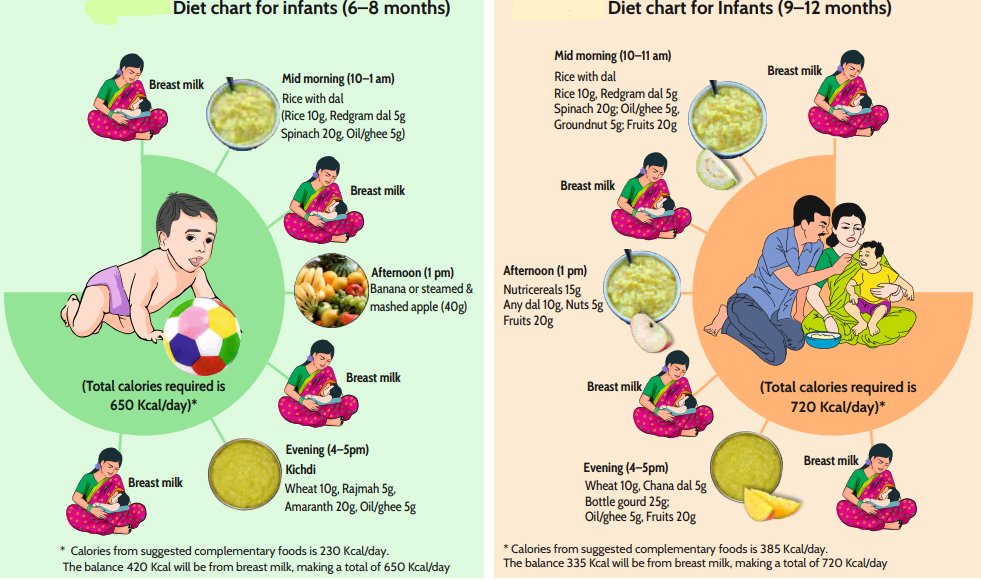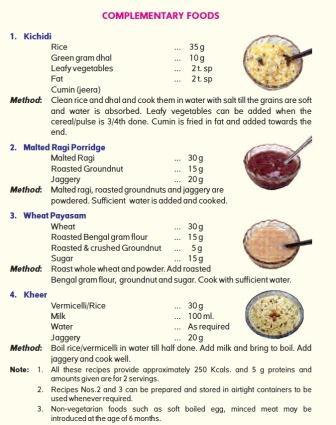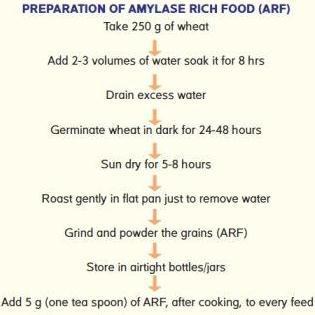Hygenic and Healthy Foods for the Growing Baby
Hygenic and Healthy Foods for the Growing Baby
- Key points
- What is complementary feeding?
- Why feed complementary foods and when?
- What should be included in complementary foods?
- How to feed a young infant?
- How to introduce complementary foods to infants?
- What are the principles in preparing complementary food supplements?
- Amylase-Rich Foods (ARFs)
- What are the hygienic practices to be adopted?
- What should be done in ‘lactose intolerance’?
- How to prepare selected recipes for complementary foods
Home-made preparations are economical, easy to cook, safe and healthy for a growing baby
Key points
- Breast milk alone is not enough to meet the increase in requirements for a child after six months of age.
- Complementary foods should be introduced soon after six months of age, in addition to breastfeeding should be continued till two years of age.
- Prefer home-made complementary foods.
- Feed complementary food at least 2–4 times a day depending upon the child's age.
- Provide milk, locally available fruits and vegetables as well as eggs and meat.
- Observe hygienic practices while preparing and feeding complementary foods.
- Complementary feeding along with breastfeeding should be continued even during diarrhea or other common illnesses to prevent malnutrition.
- Limit use of salt in complementary food preparation.
- Avoid foods (biscuits, cakes) and beverages (fruit juices and cool drinks) with added sugar.
Rationale: Home-made preparations are economical, easy to cook, safe and healthy for a growing baby
- Breast milk alone is not adequate for the infant to sustain optimal growth beyond six months of age.
- Timely introduction of complementary foods with appropriate quality and adequate quantity will ensure optimal growth.
- Feeding of adequate and appropriate complementary foods along with breastfeeding is essential for meeting increased nutrient requirements of growing infants soon after completion of six months of age.
- Breastfeeding is recommended to be continued along with complementary foods for at least up to two years.
- During complementary feeding, hygienic practices should be followed while preparing food and feeding in order to prevent diarrhea and infections.
- Limit use of salt in complementary food preparations.
- Avoid feeding foods and beverages with added sugar
However, often, children are solely breastfed even beyond six months in the belief that breast milk alone is adequate for a child until the baby is able to pick up food and eat. Such a belief leads to poor complementary feeding practice that causes undernutrition among young children, since breast milk alone is not enough to fulfill the increase in nutrition requirements for optimal growth and development from six months onwards. Therefore, complementary foods prepared appropriately should be fed soon after six months. Feeding practices comprising selection of foods, quantity to be fed, consistency of feed and frequency of feeding are crucial.
What is complementary feeding?
Breast milk (mother's milk) alone or exclusive breastfeeding is not adequate for the growth and development of a baby when the baby turns six months. Hence, breast milk should be complemented with feeding semisolid foods to breastfed infants from 6 to 12 months.
Why feed complementary foods and when?
During the first six months of life, mother's milk alone or exclusive breastfeeding is adequate for the growth and development of a baby. Requirements of all nutrients per kg of body weight are higher for infants as they are in a rapid growth phase. Moreover, the volume as well as nutrient concentrations of breast milk gets reduced from six months onwards. Hence, to meet the higher nutrient requirements of infants from six months onwards and promote optimal growth in infants, breast milk feeding needs to be complemented with feeding of other foods. Such food items are known as complementary foods.
What should be included in complementary foods?
The total energy and protein requirements for an infant from 6 to 12 months range is from 650 to 720 Kcal/day, and 9–10.5g/day respectively. But, on an average, after six months, breast milk provides about 500 Kcal and 5g protein per day, which is inadequate for optimal growth of infants after six months of age. Hence, introduction of complementary foods for six months old infants is crucial to prevent growth faltering. In addition, micronutrient needs of infants are higher, about five to ten times higher than adult requirements on body weight basis. This is a very big challenge; hence, foods that are fed to infants need to be micronutrient-dense and should have good quality protein.
Along with cereals, nutrient dense foods such as oil seeds, nuts, milk, vegetables and fruits must be included. Flesh foods and eggs or pulses such as lentils, chickpea, kidney beans, cowpea, black gram can be good source of proteins. Fresh fruit juices or fresh fruit purees can be given but fruit juices and sugar-sweetened beverages should be avoided. Sugar or salt need not be added to complementary foods.
Infants can be introduced to thoroughly cooked whole eggs, fish and meat in small quantities from eight months onwards. If these foods are not acceptable, adequate amounts of pulses should be added to meet the nutrient requirements. Infants should also be introduced to different types of green leafy vegetables (GLVs), non-leafy vegetables and fruits that are sources of vitamins and minerals. However, be remembered that these should be thoroughly cooked and mashed before feeding. A child should not be fed a diet that is of liquid consistency (flows in a plate or thali) but is semisolid (spreads in a plate or thali). At about one year of age, a child should be introduced to the family diet. However, a child's diet should be nutritionally dense. Additional nutritious foods including milk, fruits, small amounts of nuts, oil seeds, oil/ghee are recommended to be added to enhance nutrient density of the family diet.
Adequate care should be taken when feeding a child during and after diarrhoea or any infection to prevent malnutrition.
How to feed a young infant?
Infants cannot eat large quantities of food in a single meal. Hence, they should be fed at frequent intervals (at least four times a day). Also, the food prepared for feeding should be of semi-solid consistency for easy swallowing. Do not give watery food such as ‘dal kaa pa«i’ instead give ‘mashed pulse/dals’ of a thicker consistency, when such semi-solid foods are offered initially, the infant appears to spit it out. This should not be mistaken as dislike for the food. The child is learning to swallow. The fact is that an infant cannot achieve full coordination needed for the act of swallowing and hence, brings out the food by movements of the tongue. Therefore, it is important to start feeding with semi-solid foods in small quantity (two or three teaspoons). Physiological maturity of swallowing of food of semi-solid consistency develops when such a food preparation is fed regularly. An infant should be first fed complementary food and this should be followed by breastfeeding. Breastfeeds are often well accepted and tolerated even by sick children and should be continued as long as it is acceptable. Breast milk is very beneficial for ill children since in addition to providing good amount of nutrients, breast milk promotes sodium and water transport across the gut and, thus, prevents dehydration and weight loss.
Responsive feeding : Responsive feeding refers to the mutual interaction between a parent/caregiver and a child while feeding. Such interaction is often noted in Indian tradition and should be actively promoted. Responsive feeding provides emotional support to a child and influences a child's behavior by promoting attentiveness and interest in feeding. It helps in successful progression to effort at eating independently by a child. Responsive feeding involves an active interaction and not feeding passively while watching TV, playing with the phone. At the same time, a child should not be controlled or force fed. A child should be fed slowly and patiently. One should pay attention to a child's signals of hunger (sucking on the fist, drooling, looking at food, etc.) and satiety (turning away, getting distracted and so on).
How to introduce complementary foods to infants?
While introducing complementary foods at six months, start with thin but not watery porridge (viz, dal gruel) for 4–5 days and gradually increase its thickness to slurry consistency (well mashed/pureed foods). Include new foods (viz, rice slurry, mashed potato, steamed and pureed apple etc.), one at a time, and continue feeding it regularly for 4–5 consecutive days to establish acceptance by the child. This will not only help the child to get acclimatized to the food introduced but will also inform if there is any associated food intolerance or allergy. If a child does not accept a specific food item, reintroduce after a few days. If a child shows an intolerance to a specific food item and the intolerance persists, seek medical advice for appropriate diagnosis and treatment. Once ensured and satisfied that an infant is accepting different foods and textures, appropriate and suitable food mixes can be fed regularly. Gradually, as a child grows, increase consistency of the feed from semi-solid to solid foods along with improving quantity, variety, and frequency of feeding.
Minimum acceptable diet and dietary diversity for infants and chilren in India :
A child is considered to have the minimum acceptable diet when, along with continuation of breastfeed, the child is fed adequate food items in terms of both quality and frequency of feeding. A child may be considered to have minimum dietary diversity (MDD) when the complementary foods include at least the following five foods everyday.
- cereals / millets;
- pulses / egg / meat;
- nuts and oilseeds;
- breast milk / milk and milk products;
- vegetables / GLVs and fruits.
It is recommended to avoid sugar and reduce salt intake to the bare minimum.
Minimum meal frequency
The minimum number of meals apart from breastfeeding needed for the child vary depending on the age of the child and whether the child is currently breastfed. During 6–8 months of age, a breastfed child needs to be given complementary feeds at least twice a day and during 9–24 months, this frequency needs to be increased to at least three times a day. Non-breastfed children aged 6–24 months need to be fed at least four times in a day in addition to milk
Home-made complementary foods are nutritious
Complementary foods can be prepared at home from commonly used ingredients (mentioned above). Home prepared foods are not only nutritious but are also easily digestible by infants and children. Benefits of home-made complementary foods outweigh that is provided by commercially prepared foods. Some examples of home-made complementary foods are given below. Processed foods and foods that are high in fats, salt and sugar (HFSS) must be avoided (example: biscuits, chips).

What are the principles in preparing complementary food supplements?

Weaning foods based on cereal-pulse-nut and sugar/ jaggery combinations will provide good quality protein, adequate calories and other protective nutrients. Since infants cannot consume bulky complementary food, in sufficient quantities, energy-rich foods like fats and sugars should be included in such preparations. Infants can also be fed green leafy vegetables (GLVs), which are rich, yet inexpensive, sources of vitamins and minerals. However, greens should be well cleaned before cooking lest the infants develop loose motions. Dietary fibre in green leafy vegetables can, by itself, promote the bowel movements leading to loose motions in infants. Since GLVs are rich in dietary fibre, it is advisable to initially feed only the juice of the GLVs after cooking them properly. Infants should be introduced to different vegetables and fruits gradually. It should, however, be remembered that these dietary articles should be thoroughly cooked and mashed before feeding. In families which can afford egg yolk and meat soup can be introduced. At about one year of age, the child should share the family diet.
Amylase-Rich Foods (ARFs)
Flours of germinated cereals, which are rich in the enzyme alpha-amylase, constitute ARFs. Even small amounts of this type of foods liquefy and reduce the bulk of the cereal-based diet. Thus, ARFs help in increasing the energy density of weaning gruels as well as in reducing bulk. Mothers can add ARF to increase the digestibility of the low-cost weaning foods prepared at home. As presented below, preparation of ARF is very simple and can be done by mothers at home.

What are the hygienic practices to be adopted?
Most often, diarrhea is caused by unhygienic practices followed by mothers/caregivers. It is important to ensure that hygienic practices are scrupulously followed. All the dietary ingredients should be thoroughly cleaned. Vegetables should be washed well to remove contaminants/parasites/pesticides before cutting. Vegetables should preferably be steam-cooked to reduce nutrient losses due to cooking. At the time of preparation of food or while feeding a child, mothers/caregivers should observe proper personal hygiene. Utensils used for cooking and feeding should be thoroughly washed. As feeding is likely to be time consuming, cup or plate or any other feeding utensils used for feeding a child should be kept covered to protect it from flies and insects.
A variety of home-made ready to cook foods can be prepared for use as complementary foods and such prepared foods should be stored in clean bottles or tins. These food items should be consumed within the safe shelf life of the food product.
What should be done in ‘lactose intolerance’?
During acute or chronic diarrhea, lactose intolerance is a mild and transient problem. This is due to deficiency of the enzyme lactase in intestinal cells, which is needed for digestion of lactose in the milk. This problem can be overcome by reducing the quantity of milk taken at a time or taking milk along with a cereal-pulse meal or taking milk in the form of curd. There is no need to stop milk intake in acute diarrhoea situation. In chronic diarrhoea, some children may develop lactose intolerance. In such children, milk may be stopped temporarily based on doctor's advice. A diet based on cereals and pulses or chicken and egg would allow gut to recover and following recovery, milk can then be slowly re-introduced.
How to prepare selected recipes for complementary foods
A number of different age specific recipes and snacks can be done following below process.
- Roast cereals and pulses separately under low flame and grind them coarsely like rawa.
- Mix all the ingredients together before preserving them in airtight container (ingredients should be coarse in texture and not like atta). This can be preserved for 10 to 15 days under room temperature.
- One or two tablespoons of rawa/suji to be cooked in water for about 10 to 15 minutes under low flame.
- Clean and grate/cut fresh vegetables or meat into small pieces and add them to the gruel of rawa and cook them.
- Eggs can be cracked and added to the rawa and cooked. Alternatively, eggs can be boiled separately, grated and added to the rawa gruel after cooking.
- Feed the child once it is cool. Milk is optional and can be added to enhance taste and nutrients. Alternatively, peanut powder or gingelly seed powder can be added to enhance energy and taste.
- The cooked porridge should be used within one to two hours under hygienic condition.
Egg pudding
- Beat the egg and whisk it uniformly. Not peaks are required.
- Add milk, cardamom and nutmeg powder and mix till well combined.
- Steam the moisture in a steamer or pressure cooker (without whisk) for 15-20 minutes.
- Cold it to room temperature and serve.
Egg nog
- Whisk the egg in a bowl and keep aside.
- In a heavy bottom sauce pan add the whole milk, heath the milk on low and stir occasionally until it begins to boil but do not let it boil completely.
- Remove from the stovetop; pour the whisked egg drop by drop. This is called tempering the eggs so they don't scramble.
- Once combined, pour the mixture back into the sauce pan and let it simmer on low heat. It's done when the egg mixture coats the back of a spoon.
- Turn off the heat and set the mixture aside. Grate the nutmeg into the egg nog and stir to combine.
- Pour the egg nog through a strainer into another bowl to remove any lumps and serve.
Source: ICMR - National Institute of Nutrition, Hyderabad - Dietary guidelines for Indians
Last Modified : 5/10/2024
The topic covers the importance of breast feeding ...
FSSAI has explained facts about milk and milk prod...
Here are some tips for the diet and healthy eating...
This topic explains the importance of drinking ple...
